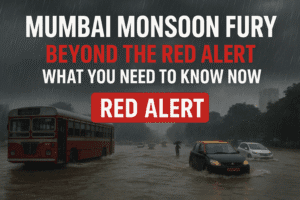Mumbai Monsoon Fury: Beyond the Red Alert – What You Need to Know Now
Mumbai faces extreme monsoon danger following an IMD RED alert issued Saturday (Aug 16th) due to relentless, heavy rainfall exceeding 200mm in areas like Vikhroli, causing severe disruption. Tragically, a rain-triggered landslide in Vikhroli killed two people, highlighting life-threatening risks beyond widespread waterlogging that paralyzed low-lying suburbs. The crisis crippled the city: over 350 flights were delayed, suburban trains halted on submerged tracks, and roads gridlocked, forcing BEST bus diversions. With thunderstorms, gusty winds, and further heavy rain (over 15mm/hour) forecast, including an Orange Alert for Sunday, the BMC urgently appeals for citizens to avoid non-essential travel and use its control room (1916) for assistance. The situation remains critical, demanding extreme caution.

Mumbai Monsoon Fury: Beyond the Red Alert – What You Need to Know Now
The India Meteorological Department’s (IMD) stark RED ALERT for Mumbai isn’t just a weather bulletin – it’s a critical warning echoing across a city grappling with intense monsoon fury. Following Saturday’s deluge that submerged streets and crippled transport, the IMD warns the crisis is far from over.
Crucial Situation Update (as of August 16th, 2025):
- Extreme Rainfall Continues: The IMD forecasts thunderstorms, lightning, and gusty winds up to 40 kmph for Mumbai (especially suburban areas) today. Heavy rain exceeding 15mm per hour is “very likely.” The relentless downpour is predicted to persist, with an Orange Alert already issued for Sunday, August 17th, signaling continued heavy to very heavy rain potential.
- State-Wide Red Alert: The danger extends beyond Mumbai. IMD Red Alerts are active for Thane, Raigad, Ratnagiri, Aurangabad, Jalna, Beed, Nanded, Parbhani, and Hingoli. Warnings for “Heavy to Very Heavy Rainfall with Extremely Heavy falls at isolated places” also cover Gujarat Region, Madhya Maharashtra, Telangana, and Vidarbha.
- Tragic Toll & Severe Impact: The rain’s violence became tragically clear early Saturday when a landslide triggered by the downpour in Vikhroli (Parksite) killed two people and injured two others after burying a hut. This underscores the very real, life-threatening risks beyond waterlogging.
- Record-Breaking Deluge: Data reveals the scale:
- Vikhroli: 248.5 mm (Highest)
- Santacruz, Sion, Juhu: Over 200 mm
- Numerous other areas also recorded rainfall exceeding 200mm within 24 hours.
- City Brought to a Standstill:
- Severe Waterlogging: Low-lying areas across Eastern & Western suburbs (Vikhroli, Ghatkopar, Bhandup, Chunabhatti, Andheri, Malad, Goregaon, Kings Circle, Aarey) are inundated.
- Transport Collapse:
- Trains: Severe disruptions on Central & Western lines due to submerged tracks (Matunga, Sion, Kurla, Vidyavihar, Ghatkopar, Bhandup, Wadala, Chunabhatti, Tilak Nagar). Harbour Line also crippled.
- Roads: Traffic gridlocked across the city. BEST buses diverted from multiple flooded locations.
- Air Travel: Over 350 flights delayed at Mumbai airports Saturday. An IndiGo aircraft also suffered a tail strike during a rain-affected go-around maneuver.
- BMC’s Urgent Plea: The Brihanmumbai Municipal Corporation is unequivocal: “Avoid stepping out unless absolutely necessary.” Their emergency systems are activated, focusing on drainage, sewage, and pumping stations. Crucial Contact: BMC Disaster Control – Dial 1916.
Human Insight: Navigating the Crisis
This isn’t just “heavy rain.” It’s a compounding urban emergency. The Red Alert signifies a high probability of widespread damage, disruption, and danger to life. The Vikhroli landslide is a grim reminder that saturated hillsides in and around the city become unstable death traps.
- Why “Over 200mm” Matters: This isn’t just a number. It translates to massive volumes of water overwhelming Mumbai’s drainage capacity in a short time, leading to rapid flooding, structural risks, and making movement perilous.
- The Real Cost of Disruption: Stranded commuters, cancelled appointments, delayed essential supplies, business losses, and the immense strain on emergency services – the ripple effects touch every Mumbaikar.
- Beyond the Headlines: While infrastructure struggles, the human cost is immense – from the families mourning in Vikhroli to hourly wage workers facing days without income, and residents trapped in waterlogged homes.
What This Means for You (Practical Advice):
- HEED THE ALERTS: Treat the Red/Orange alerts with utmost seriousness. Cancel non-essential travel.
- STAY INFORMED, STAY INDOORS: Monitor official IMD updates (@Indiametdept) and BMC advisories. Their “stay home” plea is for your safety.
- KNOW YOUR ZONE: Be aware if you live in a low-lying area, near hillsides, or in a known flood-prone locality. Have an evacuation plan if advised.
- ESSENTIAL TRAVEL ONLY: If travel is unavoidable, check real-time road/train/flight status meticulously before leaving. Expect severe delays and diversions. Avoid flooded roads and underpasses.
- PREPARE & COMMUNICATE: Charge devices, have torches/batteries ready, keep essential medicines accessible, and ensure family knows your whereabouts. Pack a small emergency bag.
- REPORT & ASSIST: Report waterlogging, fallen trees, or landslides to BMC on 1916. Check on vulnerable neighbors if safe to do so.
The Takeaway:
Mumbai is facing a severe weather crisis. The Red Alert is a call for heightened vigilance and precaution, not panic. Respect the power of this monsoon surge. Prioritize safety, follow official instructions, support each other, and understand that recovery will take time even after the rain eases. The focus now is on enduring this intense phase with minimal harm. Stay safe, Mumbai.
You must be logged in to post a comment.